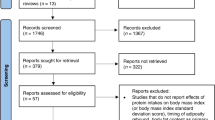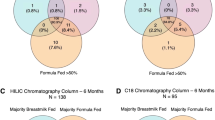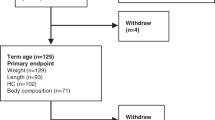Abstract
Background:
The combination of maternal obesity in early pregnancy and high protein intake in infant formula feeding might predispose to obesity risk in later life.
Methods:
This study assesses the impact of breast- or formula-feeding (differing in protein content by 1.65 or 2.7 g/100 kcal) on the metabolism of term infants from overweight and obese mothers. From birth to 3 mo of age, infants received exclusively either breast- or starter formula-feeding and until 6 mo, exclusively either a formula designed for this study or breast-feeding. From 6 to 12 mo, infants received complementary weaning food. Metabonomics was conducted on the infants’ urine and stool samples collected at the age of 3, 6, and 12 mo.
Results:
Infant formula-feeding resulted in higher protein-derived short-chain fatty acids and amino acids in stools. Urine metabonomics revealed a relationship between bacterial processing of dietary proteins and host protein metabolism stimulated with increasing protein content in the formula. Moreover, formula-fed infants were metabolically different from breast-fed infants, at the level of lipid and energy metabolism (carnitines, ketone bodies, and Krebs cycle).
Conclusion:
Noninvasive urine and stool metabolic monitoring of responses to early nutrition provides relevant readouts to assess nutritional requirements for infants’ growth.
Similar content being viewed by others
Log in or create a free account to read this content
Gain free access to this article, as well as selected content from this journal and more on nature.com
or
References
Sebire NJ, Jolly M, Harris JP, et al. Maternal obesity and pregnancy outcome: a study of 287,213 pregnancies in London. Int J Obes Relat Metab Disord 2001;25:1175–82.
Whitaker RC . Predicting preschooler obesity at birth: the role of maternal obesity in early pregnancy. Pediatrics 2004;114:e29–36.
Weng SF, Redsell SA, Swift JA, Yang M, Glazebrook CP . Systematic review and meta-analyses of risk factors for childhood overweight identifiable during infancy. Arch Dis Child 2012;97:1019–26.
Sewell MF, Huston-Presley L, Super DM, Catalano P . Increased neonatal fat mass, not lean body mass, is associated with maternal obesity. Am J Obstet Gynecol 2006;195:1100–3.
Yang Z, Huffman SL . Nutrition in pregnancy and early childhood and associations with obesity in developing countries. Matern Child Nutr 2013;9:Suppl 1:105–19.
Whitaker RC, Wright JA, Pepe MS, Seidel KD, Dietz WH . Predicting obesity in young adulthood from childhood and parental obesity. N Engl J Med 1997;337:869–73.
Adair LS, Fall CH, Osmond C, et al.; COHORTS group. Associations of linear growth and relative weight gain during early life with adult health and human capital in countries of low and middle income: findings from five birth cohort studies. Lancet 2013;382:525–34.
McMillen IC, Robinson JS . Developmental origins of the metabolic syndrome: prediction, plasticity, and programming. Physiol Rev 2005;85:571–633.
Koletzko B, Aggett PJ, Bindels JG, et al. Growth, development and differentiation: a functional food science approach. Br J Nutr 1998;80:Suppl 1:S5–45.
Li C, Kaur H, Choi WS, Huang TT, Lee RE, Ahluwalia JS . Additive interactions of maternal prepregnancy BMI and breast-feeding on childhood overweight. Obes Res 2005;13:362–71.
Rasmussen KM, Hilson JA, Kjolhede CL . Obesity as a risk factor for failure to initiate and sustain lactation. Adv Exp Med Biol 2002;503:217–22.
Rasmussen KM, Kjolhede CL . Prepregnant overweight and obesity diminish the prolactin response to suckling in the first week postpartum. Pediatrics 2004;113:e465–71.
Ohlund I, Hernell O, Hörnell A, Stenlund H, Lind T . BMI at 4 years of age is associated with previous and current protein intake and with paternal BMI. Eur J Clin Nutr 2010;64:138–45.
Butte NF, Fox MK, Briefel RR, et al. Nutrient intakes of US infants, toddlers, and preschoolers meet or exceed dietary reference intakes. J Am Diet Assoc 2010;110:Suppl 12:S27–37.
Rolland-Cachera MF, Deheeger M, Akrout M, Bellisle F . Influence of macronutrients on adiposity development: a follow up study of nutrition and growth from 10 months to 8 years of age. Int J Obes Relat Metab Disord 1995;19:573–8.
Singhal A, Kennedy K, Lanigan J, et al. Nutrition in infancy and long-term risk of obesity: evidence from 2 randomized controlled trials. Am J Clin Nutr 2010;92:1133–44.
Koletzko B, von Kries R, Closa R, et al.; European Childhood Obesity Trial Study Group. Lower protein in infant formula is associated with lower weight up to age 2 y: a randomized clinical trial. Am J Clin Nutr 2009;89:1836–45.
Arenz S, Rückerl R, Koletzko B, von Kries R . Breast-feeding and childhood obesity–a systematic review. Int J Obes Relat Metab Disord 2004;28:1247–56.
Harder T, Bergmann R, Kallischnigg G, Plagemann A . Duration of breastfeeding and risk of overweight: a meta-analysis. Am J Epidemiol 2005;162:397–403.
Fanos V, Antonucci R, Barberini L, Atzori L . Urinary metabolomics in newborns and infants. Adv Clin Chem 2012;58:193–223.
Moco S, Collino S, Rezzi S, Martin FP . Metabolomics perspectives in pediatric research. Pediatr Res 2013;73(4 Pt 2):570–6.
Nicholson JK . Global systems biology, personalized medicine and molecular epidemiology. Mol Syst Biol 2006;2:52.
Martin FP, Collino S, Rezzi S, Kochhar S . Metabolomic applications to decipher gut microbial metabolic influence in health and disease. Front Physiol 2012;3:113.
Antonucci R, Atzori L, Barberini L, Fanos V . Metabolomics: the “new clinical chemistry” for personalized neonatal medicine. Minerva Pediatr 2010;62:3 Suppl 1:145–8.
Marincola FC, Noto A, Caboni P, et al. A metabolomic study of preterm human and formula milk by high resolution NMR and GC/MS analysis: preliminary results. J Matern Fetal Neonatal Med 2012;25:Suppl 5:62–7.
Fanos V, Iacovidou N, Puddu M, Ottonello G, Noto A, Atzori L . Metabolomics in neonatal life. Early Hum Dev 2013;89:Suppl 1:S7–10.
Xia J, Mandal R, Sinelnikov IV, Broadhurst D, Wishart DS . MetaboAnalyst 2.0–a comprehensive server for metabolomic data analysis. Nucleic Acids Res 2012;40:W127–33.
Koletzko B . Long-term consequences of early feeding on later obesity risk. Nestle Nutr Workshop Ser Pediatr Program 2006;58:1–18.
Ziegler EE . Growth of breast-fed and formula-fed infants. Nestle Nutr Workshop Ser Pediatr Program 2006;58:51–9; discussion 59–63.
Savino F, Fissore MF, Grassino EC, Nanni GE, Oggero R, Silvestro L . Ghrelin, leptin and IGF-I levels in breast-fed and formula-fed infants in the first years of life. Acta Paediatr 2005;94:531–7.
Savino F, Nanni GE, Maccario S, Oggero R, Mussa GC . Relationships between IGF-I and weight Z score, BMI, tricipital skin-fold thickness, type of feeding in healthy infants in the first 5 months of life. Ann Nutr Metab 2005;49:83–7.
Barker HA . Pathway of 5-aminovalerate degradation by Clostridium aminovalericum. Curr Top Cell Regul 1985;26:349–54.
Martin FP, Sprenger N, Montoliu I, Rezzi S, Kochhar S, Nicholson JK . Dietary modulation of gut functional ecology studied by fecal metabonomics. J Proteome Res 2010;9:5284–95.
Brusilow SW . Phenylacetylglutamine may replace urea as a vehicle for waste nitrogen excretion. Pediatr Res 1991;29:147–50.
Mokhtarani M, Diaz GA, Rhead W, et al. Urinary phenylacetylglutamine as dosing biomarker for patients with urea cycle disorders. Mol Genet Metab 2012;107:308–14.
Schiff D, Chan G, Seccombe D, Hahn P . Plasma carnitine levels during intravenous feeding of the neonate. J Pediatr 1979;95:1043–6.
Olson AL, Nelson SE, Rebouche CJ . Low carnitine intake and altered lipid metabolism in infants. Am J Clin Nutr 1989;49:624–8.
Ballard O, Morrow AL . Human milk composition: nutrients and bioactive factors. Pediatr Clin North Am 2013;60:49–74.
Baur P, Martin FP, Gruber L, et al. Metabolic phenotyping of the Crohn’s disease-like IBD etiopathology in the TNF(ΔARE/WT) mouse model. J Proteome Res 2011;10:5523–35.
Rezzi S, Martin FP, Alonso C, et al. Metabotyping of biofluids reveals stress-based differences in gut permeability in healthy individuals. J Proteome Res 2009;8:4799–809.
Wold S, Esbensen K, Geladi P . Principal Component Analysis. Chemom Intell Lab Syst 1987;2:37–52.
Trygg J, Wold S . O2-PLS, a two-block (X-Y) latent variable regression (LVR) method with an integrated OSC filter. J Chemom 2003;17:53–64.
WHO Child Growth Standards. http://www.who.int/childgrowth/en. 2006.
Acknowledgements
We thank S. Colombo Mottaz and F. Chauffard for clinical trial management, D. Grathwohl and D. Egli for their scientific input and discussion in relation to the infant growth and development, and D. Barron for managerial support at NIHS to S.M.
Author information
Authors and Affiliations
Corresponding author
Supplementary information
Supplementary Figure S1
(JPEG 199 kb)
Supplementary Figure S2
(JPEG 239 kb)
Supplementary Figure S3
(JPEG 216 kb)
Supplementary Table S1
(DOC 40 kb)
Supplementary Table S2
(DOC 27 kb)
Supplementary Table S3
(DOC 29 kb)
Supplementary Table S4
(DOC 27 kb)
Supplementary Table S5
(DOC 61 kb)
Supplementary Table S6
(DOC 73 kb)
Supplementary Table S7
(DOC 26 kb)
Supplementary Methods
(DOC 41 kb)
Rights and permissions
About this article
Cite this article
Martin, FP., Moco, S., Montoliu, I. et al. Impact of breast-feeding and high- and low-protein formula on the metabolism and growth of infants from overweight and obese mothers. Pediatr Res 75, 535–543 (2014). https://doi.org/10.1038/pr.2013.250
Received:
Accepted:
Published:
Issue date:
DOI: https://doi.org/10.1038/pr.2013.250
This article is cited by
-
Effectiveness of a new approach for exclusive breastfeeding counselling on breastfeeding prevalence, infant growth velocity and postpartum weight loss in overweight or obese women: protocol for a randomized controlled trial
International Breastfeeding Journal (2020)
-
Metabolic phenotype of breast-fed infants, and infants fed standard formula or bovine MFGM supplemented formula: a randomized controlled trial
Scientific Reports (2019)
-
Metabolomic Insights into the Effects of Breast Milk Versus Formula Milk Feeding in Infants
Current Nutrition Reports (2019)
-
Role of selected amino acids on plasma IGF-I concentration in infants
European Journal of Nutrition (2017)
-
Early Infant Nutrition and Metabolic Programming: What Are the Potential Molecular Mechanisms?
Current Nutrition Reports (2014)



